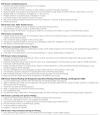Developing competencies for applied epidemiology: from process to product
- PMID: 18497021
- PMCID: PMC2233728
- DOI: 10.1177/00333549081230S114
Developing competencies for applied epidemiology: from process to product
Abstract
Objectives: We developed competencies for applied epidemiologic practice by using a process that is based on existing competency frameworks, that engages professionals in academic and applied epidemiology at all governmental levels (local, state, and federal), and that provides ample opportunity for input from practicing epidemiologists throughout the U.S.
Methods: The model set of core public health competencies, consisting of eight core domains of public health practice, developed in 2001 by the Council on Linkages Between Academia and Public Health Practice, were adopted as the foundation of the Competencies for Applied Epidemiologists in Governmental Public Health Agencies (AECs). A panel of experts was convened and met over a period of 20 months to develop a draft set of AECs. Drafts were presented at the annual meetings of the Council of State and Territorial Epidemiologists (CSTE) and the American Public Health Association. Input and comments were also solicited from practicing epidemiologists and 14 national organizations representing epidemiology and public health.
Results: In all, we developed 149 competency statements across the eight domains of public health practice and four tiers of applied epidemiologic practice. In addition, sub- and sub-subcompetency statements were developed to increase the document's specificity. During the process, >800 comments from all governmental and academic levels and tiers of epidemiology practice were considered for the final statements.
Conclusions: The AECs are available for use in improving the training for and skill levels of practicing applied epidemiologists and should also be useful for educators, employers, and supervisors. Both CDC and CSTE plan to evaluate their implementation and usefulness in providing information for future competency development.
Figures
References
-
- Council of State and Territorial Epidemiologists. Atlanta: CSTE; 2004. [cited 2006 May 31]. 2004 national assessment of epidemiologic capacity: findings and recommendations. Also available from: URL: http://www.cste.org//Assessment/ECA/pdffiles/ECAfinal05.pdf.
-
- Association of State and Territorial Health Officials. Washington: ASTHO; 2004. [cited 2006 May 31]. State public health employee worker shortage report: a civil service recruitment and retention crisis. Also available from: URL: http://www.astho.org/pubs/Workforce-Survey-Report-2.pdf.
-
- Bureau of Health Professions, Health Resources and Services Administration (US) Public health workforce study. Rockville (MD): Department of Health and Human Services, HRSA (US); 2005. [cited 2006 May 31]. Also available from: URL: http://bhpr.hrsa.gov/healthworkforce/reports/publichealth/default.htm.
-
- Welch WH, Rose W Rockefeller Foundation General Education Committee. Institute of Hygiene. New York: Rockefeller Foundation; 1915.
Publication types
MeSH terms
Grants and funding
LinkOut - more resources
Full Text Sources
Miscellaneous



